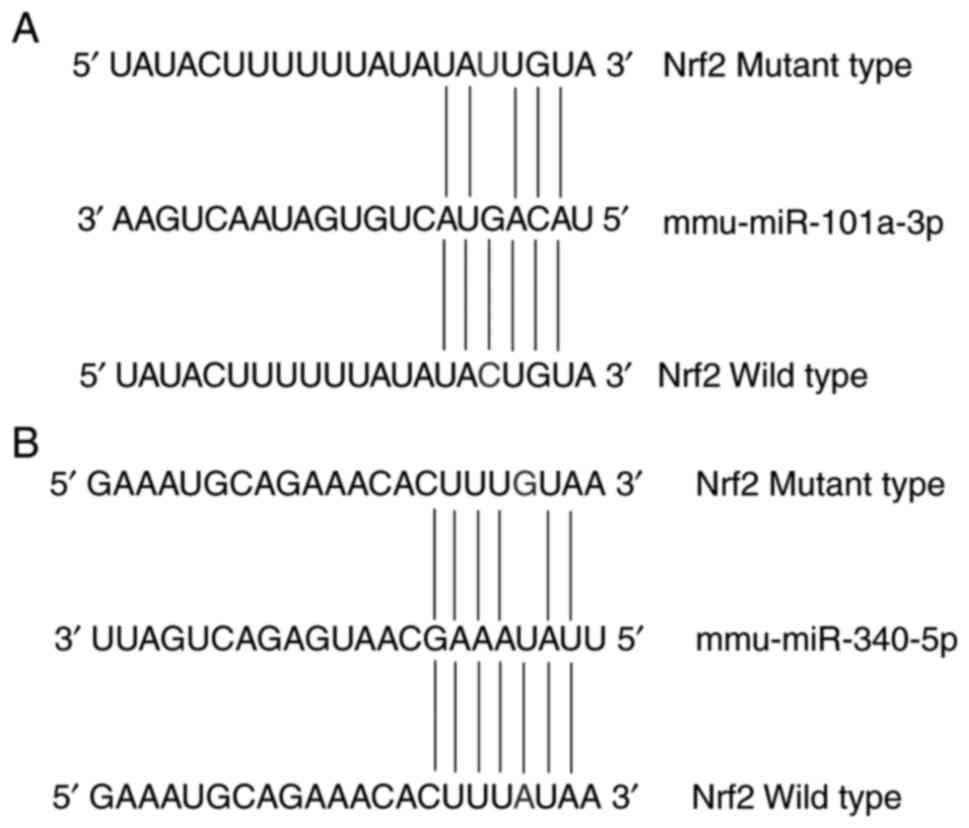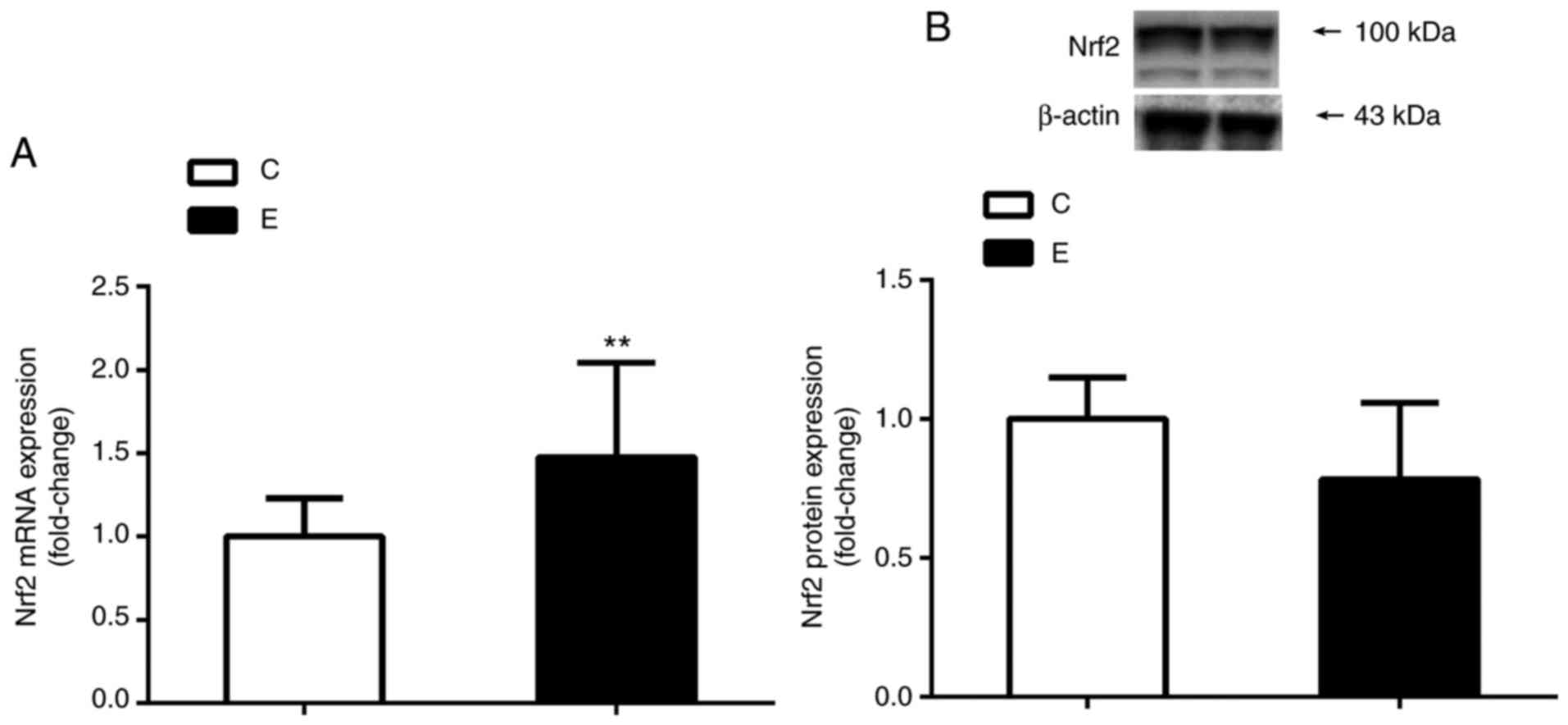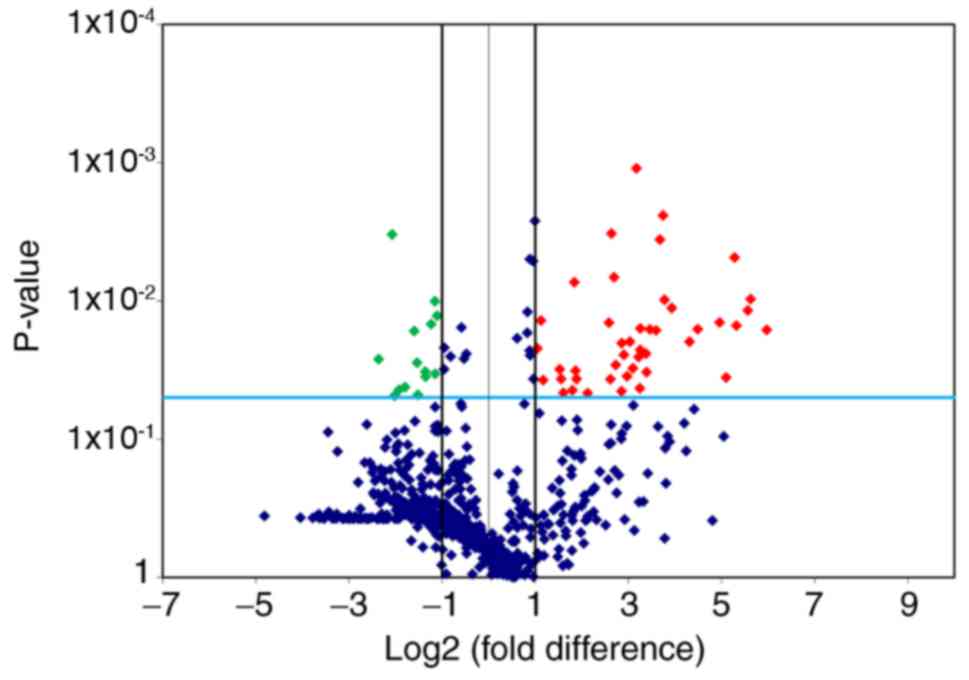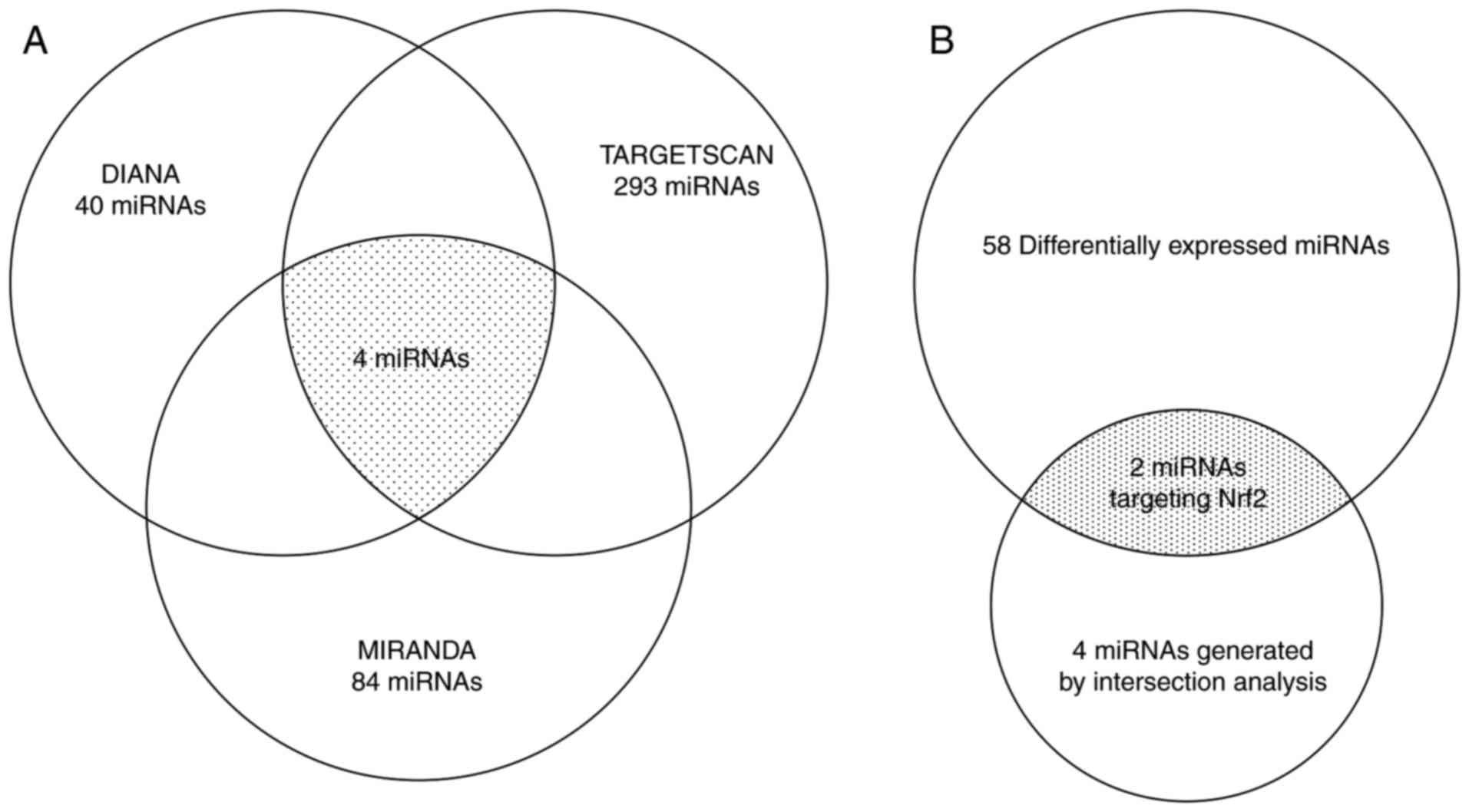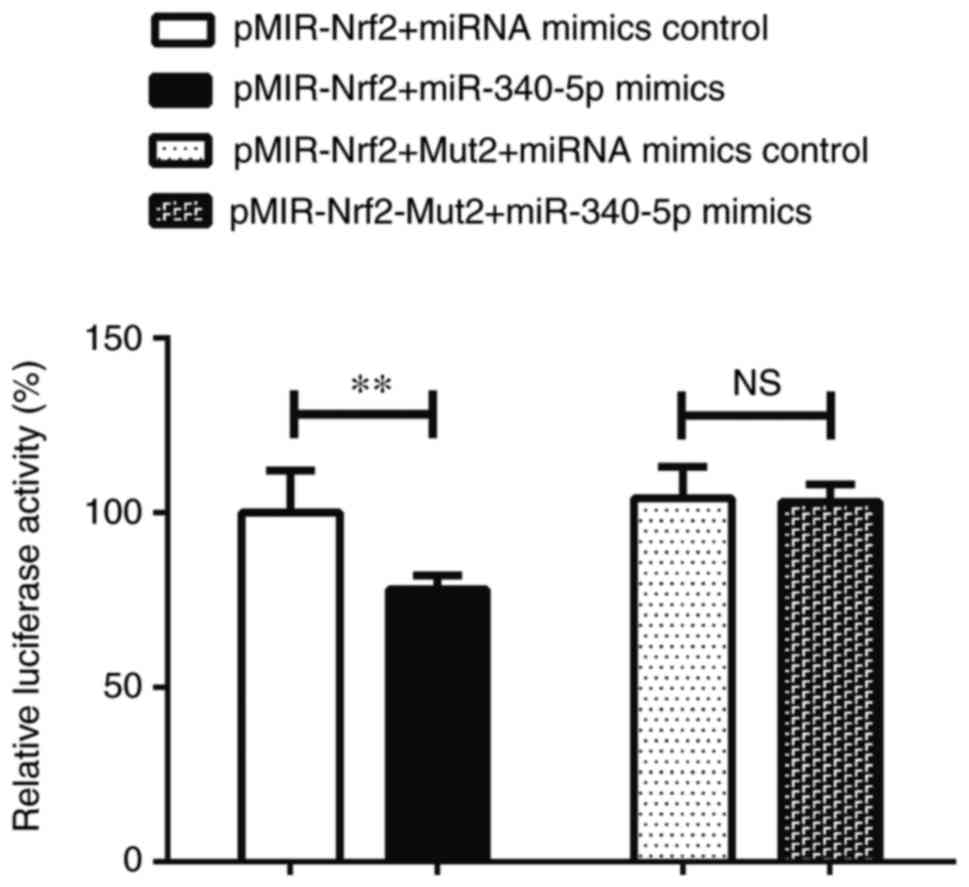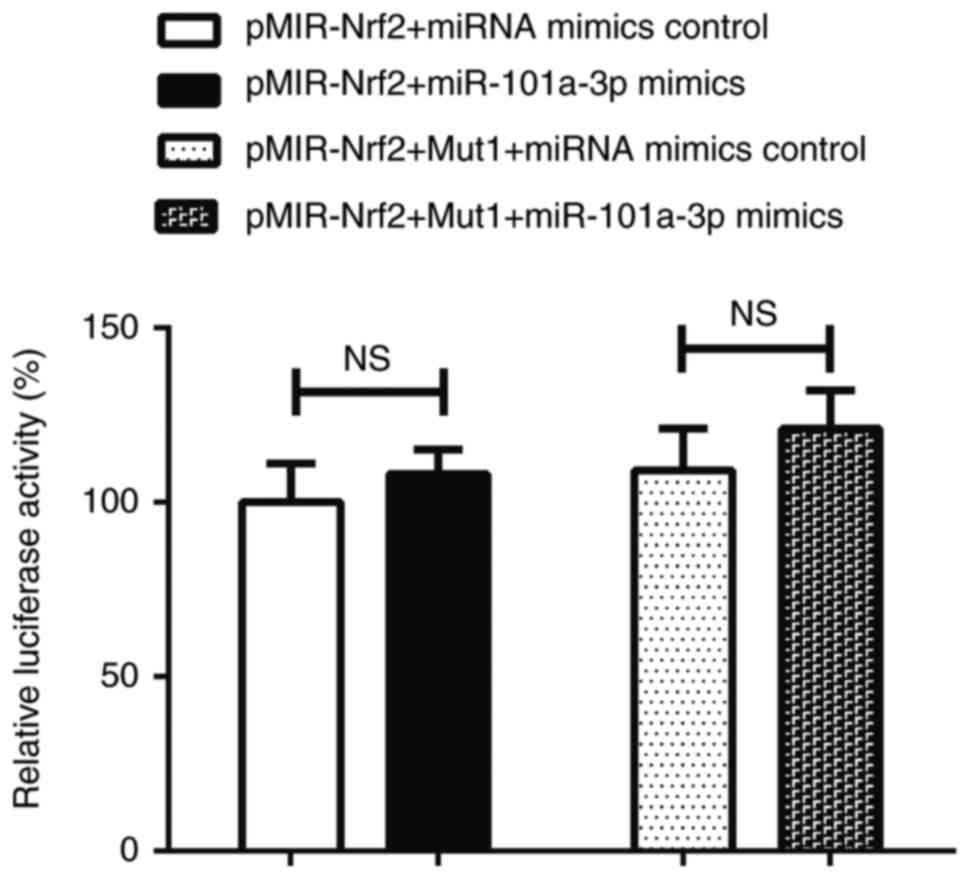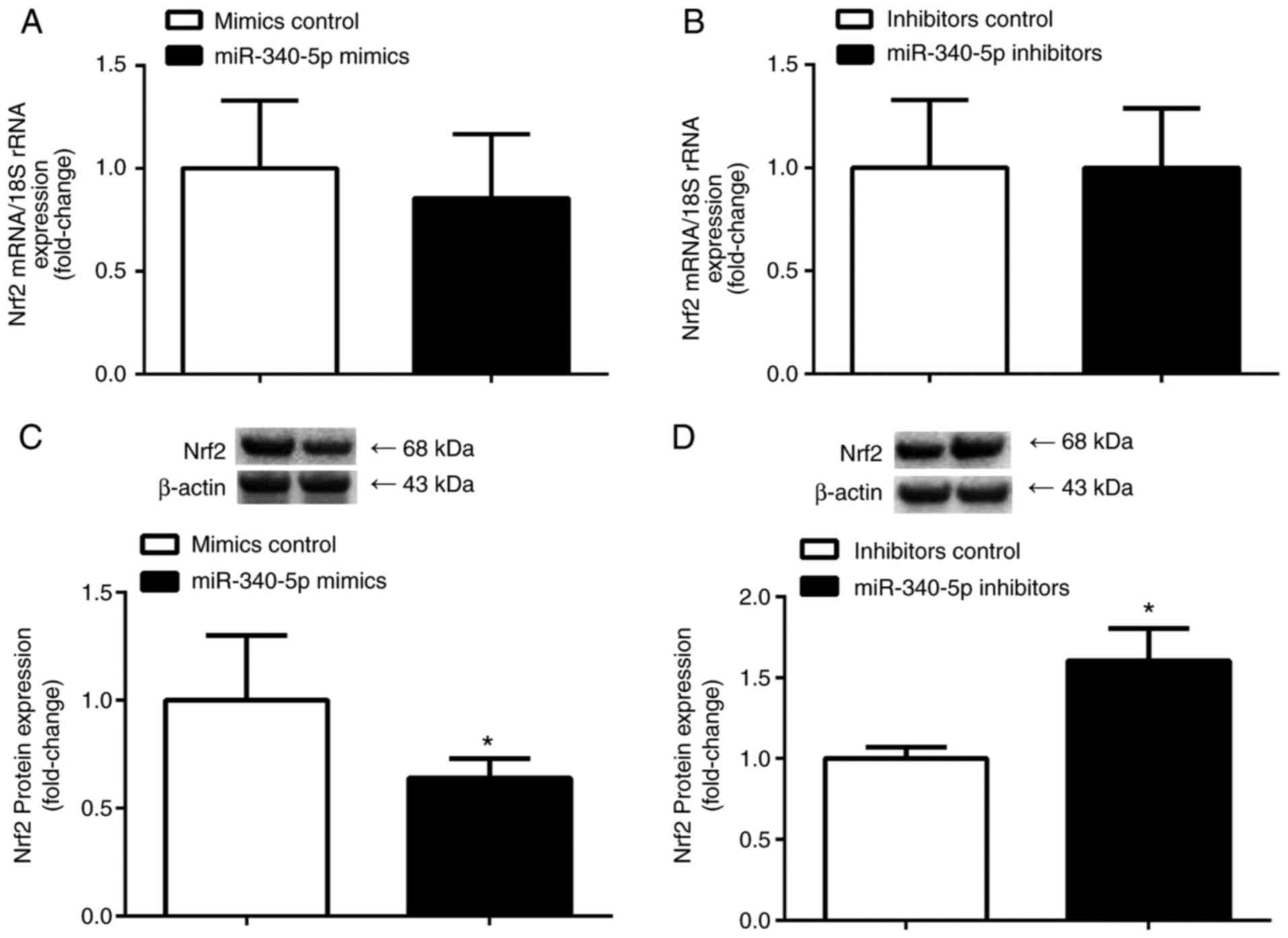miR‑340‑5p: A potential direct regulator of Nrf2 expression in the post‑exercise skeletal muscle of mice
- Authors:
- Published online on: December 13, 2018 https://doi.org/10.3892/mmr.2018.9762
- Pages: 1340-1348
Abstract
Introduction
Nuclear factor erythroid 2-related factor 2 (Nrf2) is a transcription factor that serves an important role in protecting cells from oxidative stress (1). Nrf2 protein contains the Kelch-like ECH-associated protein 1 (Keap1) binding domain. Under normal conditions, Nrf2 forms a complex with Keap1 and is of a low concentration in the cytoplasm (2). Researchers have reported that reactive oxygen species (ROS), key factors that activates Nrf2, induces the dissociation of Keap1 from Nrf2, permitting the translocation of Nrf2 into the nucleus (3). Once in the nucleus, Nrf2 heterodimerizes with small muscle aponeurotic fibrosarcoma (Maf) protein and then binds to the antioxidant response element (ARE) of downstream antioxidant genes, activating their transcription (4). An increasing body evidence indicates that exercise upregulates the expression of Nrf2 in various tissues, which protects cells from ROS-induced damage (5–9). Our recent pilot study using mouse skeletal muscle revealed no significant changes in the expression levels of Nrf2 protein following eight weeks of aerobic exercise training; however, this may be due to relatively low exercise intensities. Notably, the expression levels of Nrf2 mRNA increased significantly in the experiment. This discrepancy may suggest that post-transcriptional control and/or post-translational modification are involved in the regulation of Nrf2 expression in mouse skeletal muscle post-exercise. Among the multiple factors that may affect Nrf2 protein expression, microRNAs (miRNAs/miRs) have been proposed as key post-transcriptional regulators of gene expression (10).
miRNAs are short non-coding RNAs of ~21 nucleotides in length and serve a central role in many aspects of cell biology (11,12). Typically, by binding to the 3′ untranslated region (3′UTR) of a complementary mRNA sequence, miRNAs can directly degrade the transcript or inhibit translation (11–13). Previous studies of normal and cancer cells have reported that few miRNAs could directly or indirectly regulate Nrf2 (14–19). It has been suggested that miR-144 (15), miR-28 (14,20), miR-153, miR-27a and miR-142-5p could directly regulate Nrf2 (18); miR-200a (16), miR-23a (17) and miR-141 (18,19) targeted Keap1 (a negative regulator of Nrf2) to indirectly promote the degradation of Nrf2 protein. In addition, miR-155 disrupted the Nrf2-dependent signaling pathway in hepatic cells; however, whether this occurs in a direct or indirect manner remains unknown (21). Nevertheless, miRNAs modulating the expression of Nrf2 induced by aerobic exercise training have not been well studied. However, accumulating evidence suggests that the expression levels of some miRNAs, including miR-1, miR-107, miR-161, miR-23, miR-133 and miR-486, known as the skeletal muscle-specific microRNAs (myomiRs), tend to be regulated in response to exercise training (22,23).
On this basis, the aim of the present study was to screen and identify the potential miRNAs that directly regulate Nrf2 expression within the skeletal muscle of mice following exercise. The present study first evaluated the effects of an 8-week aerobic exercise training program on the expression of Nrf2 mRNA and protein, and miRNAs in mouse skeletal muscle. Secondly, the profile of differentially expressed miRNAs in the exercise and non-exercise control groups was analyzed and filtered to determine putative miRNAs that target the 3′UTR of Nrf2. Finally, in vitro analysis was conducted to verify the selected candidate miRNAs. The present study aimed to improve understanding of the regulatory mechanism of miRNAs in the effects of aerobic exercise training on the expression Nrf2 protein in skeletal muscle.
Materials and methods
Animal and exercise program
The present study was approved by the Animal Care and Use Committee of Beijing Sport University (Beijing, China). A total of 20 male C57BL/6J mice (20±2 g, 8-weeks-old) were purchased from Charles River Development, Inc. (Beijing, China) with a body weight of 18±2 g. The animals were housed indoors under a temperature of 20–25°C, humidity of 50–70%, 12-h light/dark cycles, and had ad libitum access to deionized water and standard chow. They were randomly divided into the control (C; n=10) and exercise (E; n=10) groups. Mice in the C group were housed without exercise training. Mice in the E group were trained according to an aerobic exercise protocol, which was adopted from a previous study with some modifications (24). Briefly, two days prior to the formal exercise protocol, the animals were familiarized to running on a treadmill at a low intensity for 10 min/day, following which the animals were made to run on the treadmill for 1 h at 12 m/min. Mice of the E group were trained 6 days per week for a total of 8 weeks. To avoid acute effects from the last exercise session, the trained mice were able to recover for at least 48 h with free access to food and water prior to tissue collection. The mice were euthanized by cervical dislocation and whole hind limb muscle samples (a mixture of muscles) were excised, cleaned of blood and connective tissue, rapidly frozen in liquid nitrogen, and stored at −80°C.
Reverse transcription-quantitative polymerase chain reaction (RT-qPCR) analysis of Nrf2 mRNA
Total RNA was extracted from C2C12 cells (China Agricultural University, Beijing, China) or 50 mg of whole hind-limb muscles (a mixture of muscles) with TRIzol® reagent (Invitrogen; Thermo Fisher Scientific, Inc., Waltham, MA, USA) following the manufacturer's instructions. RT-PCR was carried out using the ReverTra Ace Qpcr RT kit (Toyobo Life Science, Osaka, Japan), and was performed in a reaction volume of 20 µl containing 2 µl total RNA, 1 µl primer mix, 1 µl RT enzyme mix, 4 µl 5X RT buffer and 6 µl nuclease-free water. For the synthesis of cDNA, the reaction mixtures were incubated at 65°C for 5 min, 37°C for 15 min and 98°C for 5 min. qPCR was performed on an ABI 7500 Real-time PCR System (Applied Biosystems; Thermo Fisher Scientific, Inc.) using the SYBR Green Real-time PCR Master Mix kit (Toyobo Life Science) with the previously synthesized cDNA template (FSQ-101 Toyobo Life Science) in a reaction volume of 20 µl. The primers obtained from Qiagen GmbH (Hilden, Germany) were as follows: Nrf2 (cat. no. QT00095270) and 18S gene (cat. no. QT010036875) as a reference gene, which were confirmed with software (ABI 7500RT PCR). qPCR was performed with a final volume of 20 µl containing 10 µl SYBR Green Real-time PCR Master Mix, 2 µl primers, 2 µl cDNA and 6 µl nuclease-free water. The thermocycling conditions were as follows: 95°C for 10 min, then 40 cycles of 95°C for 15 sec, 60°C for 60 sec and 72°C for 30 sec. The difference in expression between the E and C groups was calculated using the 2−∆∆Cq method, as described previously (25). To assess the specificity of the amplified PCR products, melting curve analysis was conducted following the last cycle.
Western blotting analysis
Once total protein (20 µg) from 50 mg mouse skeletal muscle samples or total protein (10 µg) from C2C12 cells (2.5×105 per well) was extracted using radioimmunoprecipitation assay buffer (Beyotime Institute of Biotechnology, Shanghai, China), the protein concentration was determined with a bicinchoninic acid kit (Thermo Fisher Scientific, Inc.). Proteins were separated on a Bolt Bis-Tris plus 4–12% gel (Thermo Fisher Scientific, Inc.) by electrophoresis at 200 V for 35 min; the fractionated proteins were then transferred to a nitrocellulose transfer membrane using the iBlot Gel Transfer System (Invitrogen; Thermo Fisher Scientific, Inc.) at 20 V for 7 min and 30 sec. The membrane was blocked for 60 min at the room temperature in Tris-buffered saline with 0.01% Tween-20 (TBST) containing 5% nonfat milk. The samples were then incubated overnight at 4°C using the following primary antibodies: Anti-Nrf2 antibodies (1:200, cat. no. sc-722; and 1:2,000, cat. no. sc-365949; Santa Cruz Biotechnology, Inc., Dallas, TX, USA), and β-actin antibody (1:1,000; cat. no. sc-47778; Santa Cruz Biotechnology, Inc.). Of the primary antibodies against NRF2, the sc-722 antibody was used in animal experiments and the sc-365949 antibody was used in cell experiments. The blots were washed 3 times with 1X TBST, then incubated with an anti-rabbit horseradish peroxidase-conjugated secondary antibody (1:2,000; cat. no. zb-2301; OriGene Technologies, Inc., Beijing, China) at 37°C for 1 h. Following washing with 1X TBST, the blots were visualized with an ECL Western Blotting Substrate (Thermo Fisher Scientific, Inc.). The density of the protein bands was analyzed using the Molecular Imager® ChemiDoc™ XRS + with Image Lab™ Software version 6.0.0 (Bio-Rad Laboratories, Inc., Hercules, CA, USA). The protein expression levels were normalized to that of β-actin and then expressed as the fold change of the control group.
miScript miRNA PCR array
Total RNA of skeletal muscle from 50 mg muscle samples was extracted using an miRNeasy Mini kit (Qiagen GmbH). The total RNA was assessed with a NanoDrop 2000 spectrophotometer (NanoDrop Technologies; Thermo Fisher Scientific, Inc., Wilmington, DE, USA), and its quality fulfilled the requirements of total RNA absorbance ratios: >2.0 (260/280 nm) and >1.8 (260/230 nm). Then, 1.5 ng RNA was employed to conduct RT-PCR to produce cDNA with the miScript II RT kit (Qiagen GmbH). RT-PCR was performed in a reaction volume of 20 µl containing 2 µl total RNA, 4 µl 5X miScript HiSpec Buffer, 2 µl 10X miScript Nucleics Mix, 2 µl miScript Reverse Transcriptase Mix and 10 µl nuclease-free water. The reaction mixtures were incubated at 37°C for 60 min and 95°C for 5 min. miRNA expression was analyzed using a miScript miRNA PCR Array (Qiagen GmbH) according to the manufacturer's instructions. Prior to analysis, the miScript miRNA quality control PCR Array was employed to determine the quality of the extracted cDNA template, which met the criterion for conducting miScript miRNA PCR array analysis. In addition, 96-well plates were used to determine the expression profile of 940 miRNAs from one mouse muscle sample via array analysis. A reaction mix with a final volume of 25 µl containing 12.5 µl 2X QuantiTect SYBR Green Master Mix, 2.5 µl 10X miScript Universal Primer, 1 µl cDNA and 9 µl nuclease-free water was employed. The thermocycling conditions were as follows: 95°C for 15 min, followed by 40 cycles of 94°C for 15 sec, 55°C for 30 sec and 70°C for 30 sec. The Cq values were obtained using an ABI 7500 Real-time PCR System (Applied Biosystems; Thermo Fisher Scientific, Inc.) and were analyzed using online data analysis tools based on the ΔΔCq method (relative gene expression=2−(ΔCq sample−ΔCq control) (25). The P-value and log2 fold change (log2 FC) between the C and E groups were calculated; P<0.05 and |log2 FC| ≥1 were regarded to indicate differentially expressed miRNAs.
Bioinformatics prediction
TargetScan v7.1 (www.targetscan.org/) (26–28), miRanda (released August 2010, www.microrna.org/) (29,30) and DIANA v4.0 (diana.imis.athena-innovation.gr/DianaTools/index.php?r=microT_CDS/index) (31,32) were used to predict the putative miRNAs that target the 3′UTR of Nrf2. To reduce the number of false positives and increase fidelity, the intersection of the prediction results from these three tools was considered to indicate the putative miRNAs. In addition, by analyzing the selected differentially expressed miRNAs with the miScript miRNA PCR array, miR-340-5p and miR-101a-3p were proposed to be the miRNAs that may target Nrf2 mRNA following 8 weeks of aerobic exercise.
miRNA mimics and plasmid construction
miRNA mimics are innovative molecules designed for gene silencing approaches that contain non-natural or artificial double stranded miRNA-like RNA fragments (33). These RNA fragments are constructed to contain a sequence motif on its 5′-end that is partially complementary to the target sequence in the 3′UTR of the transcript (33). On this basis, miRNA mimics and a control were purchased from Guangzhou RiboBio Co., Ltd. (Guangzhou, China). The sequences were as follows: miR-101a-3p mimic, 5′-UACAGUACUGUGAUAACUGAA-3′; miR-340-5p mimic, 5′-UUAUAAAGCAAUGAGACUGAUU-3′; and mimic control, 5′-UUUGUACUACACAAAAGUACUG-3′.
The pMIR-Report luciferase and the control reporter pRL-TK plasmids were purchased from Ambion (Thermo Fisher Scientific, Inc.). The full length 3′UTR sequence of Nrf2 containing the putative target site for miR-101a-3p or miR-340-5p was synthesized, and then inserted into the XhoI and HindIII sites of the pMIR-Report luciferase vector by GENEWIZ Beijing (Beijing, China); the construct was named pMIR-Nrf2. A mutation of Nrf2 3′UTR in the putative binding site of miR-101a-3p or miR-340-5p was introduced into the putative seed-matching sequence of pMIR-Nrf2 (Fig. 1A and B); these constructs were named pMIR-Nrf2-Mut1 for miR-101a-3p and pMIR-Nrf2-Mut2 for miR-340-5p. As determined from the miRanda database (www.microrna.org/microrna/home.do), miR-340-5p was predicted to target two binding sites within the 3′UTR of Nrf2 at 84–90 (mirSVR score=−0.9843) and 366–380 (mirSVR score=−0.1789), while miR-101a-3p had two binding sites located at 258–263 (mirSVR score=−0.3732) and 350–355 (mirSVR score=−0.3981). MirSVR scoring is a machine learning method for ranking miRNA target sites, in which a lower mirSVR score indicates a stronger association between a miRNA and a target gene (34). Thus, the miRNA with the lowest mirSVR score was chosen as the target miRNA in the present study. A base in the target site was changed to generate a mutation in the 3′UTR of Nrf2 (Fig. 1).
Cell culture, transfection and dual luciferase reporter assay
293T cells were obtained from China Agricultural University (Beijing, China), and were cultured in complete growth medium [Dulbecco's modified Eagle's medium (DMEM) supplemented with 10% fetal bovine serum (FBS; HyClone; GE Healthcare Life Sciences, Logan, UT, USA)], 100 µg/ml penicillin and 100 µg/ml streptomycin (HyClone; GE Healthcare Life Sciences) at 37°C in a humidified incubator containing 5% CO2.
A total of ~2×105 293T cells were seeded in a 24-well plate in DMEM containing 10% FBS 24 h prior to transfection. The experiment was set for four groups as follows: pMIR-Nrf2+miRNA mimics control, pMIR-Nrf2+miRNA mimics (miR-101a-3p or miR-340-5p), pMIR-Nrf2-Mutation+miRNA mimics control, and pMIR-Nrf2-Mutation+miRNA mimics (Mutation1/Mutation2 corresponds to mutations in the putative binding sequence of miR-101a-3a and miR-340-5p, respectively). Cell transfection was performed using Lipofectamine® 2000 (Invitrogen; Thermo Fisher Scientific, Inc.) following the manufacturer's instructions. Briefly, the culture medium was replaced with Opti-minimum essential medium (MEM) from the kit. The pMIR-Report or the mutant luciferase constructs were mixed with pRL-TK at a ratio of 20:1, and miRNA mimics or the control were diluted with 50 µl Opti-MEM to a final concentration of 50 nM. These diluted components were combined and incubated for 20 min at room temperature. The mixture (100 µl) was then added to each well and the medium was replaced with DMEM containing 10% FBS following culture for 6 h; transfection was carried out in triplicate. Following a 48 h incubation, the cells were harvested and lysed in the passive lysis buffer included in the Dual-Luciferase Reporter Assay System (Promega Corporation, Madison, WI, USA). The luciferase activity of firefly and Renilla were measured using the Dual-Luciferase® Reporter Assay System in a GloMax® 20/20 luminometer (Promega Corporation); the firefly luciferase activity was normalized to that of Renilla. The relative luciferase activity was used to validate whether miR-340-5p and miR-101a-3p regulate the expression of Nrf2 by binding to the 3′UTR.
Overexpression and knockdown of miR-340-5p in C2C12 cells
miRNA inhibitors are chemically modified, single-stranded nucleic acids designed to specifically bind to and inhibit endogenous miRNA molecules (35). In the present study, C2C12 cells (1.5×105 per well) were cultured in DMEM under the same conditions as those used aforementioned for 293T cells. The cells were seeded in 6-well plates upon reaching 70% confluence the day prior to transfection. miR-340-5p mimics (5′-UUAUAAAGCAAUGAGACUGAUU-3′), inhibitors (5′-AAUCAGUCUCAUUGCUUUAUAA-3′), mimics control (5′-UUUGUACUACACAAAAGUACUG-3′) and inhibitor control (5′-UCACAACCUCCUAGAAAGAGUAGA-3′) (Guangzhou RiboBio Co., Ltd.) were transfected into C2C12 cells at a concentration of 150 nM using Lipofectamine 3000™ (Invitrogen; Thermo Fisher Scientific, Inc.) following the manufacturer's instructions. The medium was changed 24 h post-transfection; C2C12 cells were harvested following 48 h to determine the mRNA and protein expression levels of Nrf2.
Statistical analysis
Data are presented as the mean ± standard error of the mean. Cell experiments were performed in triplicate, and independently repeated at least three times. Statistical calculations were performed using SPSS 13.0 (SPSS, Inc., Chicago, IL, USA). Data were analyzed by an Independent Samples t-test. P<0.05 was considered to indicate a statistically significant difference.
Results
Effects of exercise training on Nrf2 mRNA and protein expression
The results of RT-qPCR analysis revealed that the mRNA expression levels of Nrf2 in the E group were significantly increased when compared with the C group (P<0.01). Additionally, no significant difference was observed in the levels of Nrf2 protein expression between the two groups following 8 weeks of aerobic exercise training as determined by western blotting (Fig. 2).
Effects of exercise training on miRNAs expression
According to the standards of P<0.05 and |log2 FC| ≥1, 58 significantly differentially expressed miRNAs between the C and E groups were identified in the present study. Among them, the expression levels of 14 miRNAs were downregulated (log2 FC≤-1), whereas 44 miRNAs were upregulated (log2 FC≥1) following 8 weeks of aerobic exercise training (Table I; Fig. 3).
Table I.Differential expression of microRNAs between two groups by miScript microRNA polymerase chain reaction array analysis. |
Bioinformatics prediction of the putative miRNAs that target the 3′UTR of Nrf2
DIANA, miRanda and TargetScan prediction tools identified 40, 84 and 293 miRNAs that target the 3′UTR of Nrf2, respectively; 4 miRNAs (miR-101a-3p, miR-142-5p, miR-1950 and miR-340-5p) were identified when combining the results of prediction analysis with these three tools (Fig. 4A). In addition, by combining the 58 differentially expressed miRNAs between the E and C groups (Table I), miR-101a-3p and miR-340-5p (Fig. 4B; Table I) were selected as candidate miRNAs that targeted the 3′UTR of Nrf2 and chosen for further study.
miR-340-5p may directly target 3′UTR of Nrf2 gene
As shown in Fig. 5, the relative luciferase activity in the pMIR-Nrf2+miR-340-5p mimics group was significantly lower than that of the pMIR-Nrf2+miRNA mimics control group (P<0.01). This indicated that miR-340-5p was capable of binding to the pMIR-Nrf2 plasmid and suppressed luciferase activity. Additionally, no significant difference was observed in relative luciferase activity between the pMIR-Nrf2-Mut2+miRNA mimics control and pMIR-Nrf2-Mut2+miR-340-5p mimics groups (P>0.05; Fig. 5). These results further indicated that the binding site of miR-340-5p was located within the 3′UTR of Nrf2.
miR-101a-3p does not directly target 3′UTR of Nrf2 gene
There was no significant difference in the relative luciferase activity between the pMIR-Nrf2+miR-101a-3p mimics and the pMIR-Nrf2+miRNA mimics control groups (P>0.05). In addition, there was no significant difference in relative luciferase activity between the pMIR-Nrf2-Mut1+ miRNA mimics control and pMIR-Nrf2-Mut1+miR-101a-3p mimics groups (P>0.05; Fig. 6). Therefore, these data indicated that miR-101a-3p did not suppress luciferase activity and could not bind the pMIR-Nrf2 plasmid.
Effect of miR-340-5p overexpression and knockdown on endogenous Nrf2 mRNA and protein expression levels
To demonstrate the effect of miR-340-5p on endogenous Nrf2 mRNA and protein expression levels, the present study transiently transfected C2C12 cells with miR-340-5p mimics, inhibitors or control, and the expression of Nrf2 mRNA and protein was determined. Transfection of miR-340-5p mimics or inhibitors significantly decreased and increased Nrf2 protein expression, respectively (P<0.05); however, the mRNA expression levels remained unchanged (P>0.05; Fig. 7).
Discussion
The main finding of the present study was that the mRNA expression levels of Nrf2 in skeletal muscle significantly increased following 8 weeks of aerobic exercise training, but the protein expression levels did not increase. One miRNA, miR-340-5p, was revealed to directly bind to the 3′UTR of Nrf2 and may be a direct post-transcriptional regulator of Nrf2 in skeletal muscle following aerobic exercise training.
It has been demonstrated that aerobic exercise training increased the expression levels of Nrf2 mRNA and protein in the cardiomyocytes of rats following myocardial infarction, which protected against myocardial infarction-induced oxidative injury (36); physical exercise of moderate intensity also protected against experimental 6-hydroxydopamine-induced hemi-parkinsonism through the Nrf2-ARE signaling pathway (20). Some studies have confirmed that Nrf2 protein expression in whole cell or nuclear fractions was associated with exercise intensity. For example, the effects of varying intensities of treadmill exercise on hippocampal Nrf2 protein expression in adult C57B1 male mice were studied. The results revealed that the greater the intensity of exercise, the higher the protein expression levels of Nrf2 (37). Another experiment examined the association between exercise intensity and the protein expression levels of Nrf2 in blood cells, and revealed that the greater the intensity of exercise, the higher the Nrf2 protein levels in the nucleus (38). In addition, the expression of miRNAs that are affected by exercise have been investigated. miRNA expression profiling revealed that exercise significantly increased the expression of miR-181, miR-1 and miR-107, but reduced that of miR-23; no changes in the expression of miR-133 were noted (22). In the present study, the expression levels of Nrf2 mRNA were increased, while no significant changes in Nrf2 protein expression within mouse skeletal muscle following aerobic exercise for 8 weeks were reported. It was speculated that no changes in the expression of Nrf2 protein in trained mice may be associated with lower exercise intensities. In addition, the regulation of miRNAs may be involved in targeting Nrf2 mRNA. It has been reported that miRNAs may serve important roles in post-transcriptional gene regulation by targeting mRNAs for cleavage or translational repression (39). It is well known that if a miRNA is completely complementary with an mRNA transcript, the miRNA will cleave and degrade its target; otherwise, the miRNA will bind the mRNA to execute translational inhibition (40). These results suggest that miRNA translational repression may be one of factors that lead to this discrepancy in the expression levels of Nrf2 mRNA and protein.
A total of 58 miRNAs exhibiting significant differential expression following 8 weeks of aerobic exercise intervention were studied in the present study. By combining the results of prediction analysis, and the profiles of differentially expressed miRNAs between the C and E groups, miR-340-5p and miR-101a-3p were determined to be the miRNAs that target the 3′UTR of Nrf2. To verify this, the present study measured the luciferase signals of these two miRNAs, which revealed that the luciferase activity of the pMIR-Nrf2+miR-340-5p mimics group was suppressed, while that of the pMIR-Nrf2+ miR-101a-3p mimics group was unchanged, compared with their corresponding control groups. Additionally, the luciferase activity of the plasmid with mutant type Nrf2 3′UTR was not affected by miR-340-5p or miR-101a-3p mimics. These results indicated that only miR-340-5p could target the 3′UTR of Nrf2 directly, and may be involved in downregulating the protein expression of Nrf2 following 8 weeks of aerobic exercise training; miR-101a-3p was revealed to not directly regulate Nrf2. However, it has been shown that Cullin 3 is a ubiquitous ligase that degrades Nrf2 (41). miR-101a-3p was reported to bind to the 3′UTR of Cullin 3 to suppress expression and stabilize Nrf2 via the inhibition of the proteasomal degradation pathway (4,42). Thus, miR-101a-3p may also serve an important role in targeting Nrf2 expression as an indirect regulator; however, further research is required in the future to verify this.
To investigate if miR-340-5p had an effect on the endogenous mRNA and protein expression levels of Nrf2, the present study detected the expression of Nrf2 in C2C12 cells transfected with miR-340-5p mimics or inhibitors. The results revealed that miR-340-5p mimics decreased the expression levels of Nrf2 protein, whereas the expression levels increased in response to miR-340-5p inhibitors. However, miR-340-5p mimics and inhibitors had no effect on Nrf2 mRNA expression. Taken together, it could by concluded that miR-340-5p directly regulated the expression of Nrf2 by inhibiting the translation of Nrf2 mRNA. These data further supported that in the present in vivo study, aerobic exercise may have induced the expression of miR-340-5p, inhibiting the expression of Nrf2 protein, which may explain the discrepancy in the mRNA and protein expression levels of Nrf2.
In addition, Keap1 (43), Cullin-associated and neddylation-dissociated 1 (CAND1) (44), and small Maf proteins (45) have also been reported to be important regulators of Nrf2 expression. miRNAs may indirectly affect the expression of Nrf2 by targeting Keap1, CAND1 and small Maf proteins.
In conclusion, the results of the present study provide evidence that miR-340-5p may be a miRNA that directly targets the 3′UTR of Nrf2. Therefore, miR-340-5p may be regarded as a potential direct regulator of Nrf2 expression in the post-exercise skeletal muscle of mice. These observations may provide insight into the miRNA-associated mechanisms underlying the effects of aerobic exercise training on Nrf2 protein expression in skeletal muscle.
Acknowledgements
Not applicable.
Funding
The present study was supported by the National Natural Science Foundation of China (grant no. 31471134), and the Fundamental Research Funds for the Central Universities (grant no. 2015SYS005).
Availability of data and materials
The datasets used and/or analyzed during the current study are available from the corresponding author on reasonable request.
Authors' contributions
TM and YZ conceived and designed the experiments. TM and YL performed the experiments and analyzed the data. YZ and JW contributed to the reagents/materials/analysis. TM, YZ and JW gave final approval of the version to be published.
Ethics approval and consent to participate
The present study was approved by the Animal Care and Use Committee of Beijing Sport University (Beijing, China).
Patient consent for publication
Not applicable.
Competing interests
The authors declare that they have no competing interests.
References
|
Kobayashi A, Ohta T and Yamamoto M: Unique function of the Nrf2-Keap1 pathway in the inducible expression of antioxidant and detoxifying enzymes. Methods Enzymol. 378:273–286. 2004. View Article : Google Scholar : PubMed/NCBI | |
|
Wakabayashi N, Itoh K, Wakabayashi J, Motohashi H, Noda S, Takahashi S, Imakado S, Kotsuji T, Otsuka F, Roop DR, et al: Keap1-null mutation leads to postnatal lethality due to constitutive Nrf2 activation. Nat Genet. 35:238–245. 2003. View Article : Google Scholar : PubMed/NCBI | |
|
Heiss EH, Schachner D, Werner ER and Dirsch VM: Active NF-E2-related factor (Nrf2) contributes to keep endothelial NO synthase (eNOS) in the coupled state: Role of reactive oxygen species (ROS), eNOS, and heme oxygenase (HO-1) levels. J Biol Chem. 284:31579–31586. 2009. View Article : Google Scholar : PubMed/NCBI | |
|
Kobayashi A, Kang MI, Okawa H, Ohtsuji M, Zenke Y, Chiba T, Igarashi K and Yamamoto M: Oxidative stress sensor Keap1 functions as an adaptor for Cul3-based E3 ligase to regulate proteasomal degradation of Nrf2. Mol Cell Biol. 24:7130–7139. 2004. View Article : Google Scholar : PubMed/NCBI | |
|
Wang P, Li CG, Qi Z, Cui D and Ding S: Acute exercise stress promotes Ref1/Nrf2 signalling and increases mitochondrial antioxidant activity in skeletal muscle. Exp Physiol. 101:410–420. 2016. View Article : Google Scholar : PubMed/NCBI | |
|
Tsou YH, Shih CT, Ching CH, Huang JY, Jen CJ, Yu L, Kuo YM, Wu FS and Chuang JI: Treadmill exercise activates Nrf2 antioxidant system to protect the nigrostriatal dopaminergic neurons from MPP+ toxicity. Exp Neurol. 263:50–62. 2015. View Article : Google Scholar : PubMed/NCBI | |
|
Merry TL and Ristow M: Nuclear factor erythroid-derived 2-like 2 (NFE2L2, Nrf2) mediates exercise-induced mitochondrial biogenesis and the anti-oxidant response in mice. J Physiol. 594:5195–5207. 2016. View Article : Google Scholar : PubMed/NCBI | |
|
Kumar RR, Narasimhan M, Shanmugam G, Hong J, Devarajan A, Palaniappan S, Zhang J, Halade GV, Darley-Usmar VM, Hoidal JR and Rajasekaran NS: Abrogation of Nrf2 impairs antioxidant signaling and promotes atrial hypertrophy in response to high-intensity exercise stress. J Transl Med. 14:862016. View Article : Google Scholar : PubMed/NCBI | |
|
Done AJ and Traustadottir T: Nrf2 mediates redox adaptations to exercise. Redox Biol. 10:191–199. 2016. View Article : Google Scholar : PubMed/NCBI | |
|
Ying SY, Chang DC and Lin SL: The microRNA (miRNA): Overview of the RNA genes that modulate gene function. Mol Biotechnol. 38:257–268. 2008. View Article : Google Scholar : PubMed/NCBI | |
|
Alvarez-Garcia I and Miska EA: MicroRNA functions in animal development and human disease. Development. 132:4653–4662. 2005. View Article : Google Scholar : PubMed/NCBI | |
|
Bushati N and Cohen SM: microRNA functions. Annu Rev Cell Dev Biol. 23:175–205. 2007. View Article : Google Scholar : PubMed/NCBI | |
|
Bartel DP: MicroRNAs: Target recognition and regulatory functions. Cell. 136:215–233. 2009. View Article : Google Scholar : PubMed/NCBI | |
|
Yang M, Yao Y, Eades G, Zhang Y and Zhou Q: miR-28 regulates Nrf2 expression through a Keap1-independent mechanism. Breast Cancer Res Treat. 129:983–991. 2011. View Article : Google Scholar : PubMed/NCBI | |
|
Zhou S, Ye W, Zhang Y, Yu D, Shao Q, Liang J and Zhang M: miR-144 reverses chemoresistance of hepatocellular carcinoma cell lines by targeting Nrf2-dependent antioxidant pathway. Am J Transl Res. 8:2992–3002. 2016.PubMed/NCBI | |
|
Narasimhan M, Patel D, Vedpathak D, Rathinam M, Henderson G and Mahimainathan L: Identification of novel microRNAs in post-transcriptional control of Nrf2 expression and redox homeostasis in neuronal, SH-SY5Y cells. PLoS One. 7:e511112012. View Article : Google Scholar : PubMed/NCBI | |
|
Khan AUH, Rathore MG, Allende-Vega N, Vo DN, Belkhala S, Orecchioni S, Talarico G, Bertolini F, Cartron G, Lecellier CH and Villalba M: Human leukemic cells performing oxidative phosphorylation (OXPHOS) generate an antioxidant response independently of reactive oxygen species (ROS) production. EBioMedicine. 3:43–53. 2015. View Article : Google Scholar : PubMed/NCBI | |
|
van Jaarsveld MT, Helleman J, Boersma AW, van Kuijk PF, van Ijcken WF, Despierre E, Vergote I, Mathijssen RH, Berns EM, Verweij J, et al: miR-141 regulates KEAP1 and modulates cisplatin sensitivity in ovarian cancer cells. Oncogene. 32:4284–4293. 2013. View Article : Google Scholar : PubMed/NCBI | |
|
Shi L, Wu L, Chen Z, Yang J, Chen X, Yu F, Zheng F and Lin X: miR-141 activates Nrf2-dependent antioxidant pathway via down-regulating the expression of keap1 conferring the resistance of hepatocellular carcinoma cells to 5-fluorouracil. Cell Physiol Biochem. 35:2333–2348. 2015. View Article : Google Scholar : PubMed/NCBI | |
|
Aguiar AS Jr, Duzzioni M, Remor AP, Tristão FS, Matheus FC, Raisman-Vozari R, Latini A and Prediger RD: Moderate-intensity physical exercise protects against experimental 6-hydroxydopamine-induced hemiparkinsonism through Nrf2-antioxidant response element pathway. Neurochem Res. 41:64–72. 2016. View Article : Google Scholar : PubMed/NCBI | |
|
Wan C, Han R, Liu L, Zhang F, Li F, Xiang M and Ding W: Role of miR-155 in fluorooctane sulfonate-induced oxidative hepatic damage via the Nrf2-dependent pathway. Toxicol Appl Pharmacol. 295:85–93. 2016. View Article : Google Scholar : PubMed/NCBI | |
|
Safdar A, Abadi A, Akhtar M, Hettinga BP and Tarnopolsky MA: miRNA in the regulation of skeletal muscle adaptation to acute endurance exercise in C57Bl/6J male mice. PLoS One. 4:e56102009. View Article : Google Scholar : PubMed/NCBI | |
|
Aoi W, Ichikawa H, Mune K, Tanimura Y, Mizushima K, Naito Y and Yoshikawa T: Muscle-enriched microRNA miR-486 decreases in circulation in response to exercise in young men. Front Physiol. 4:802013. View Article : Google Scholar : PubMed/NCBI | |
|
Gong H, Xie J, Zhang N, Yao L and Zhang Y: MEF2A binding to the Glut4 promoter occurs via an AMPKα2-dependent mechanism. Med Sci Sports Exerc. 43:1441–1450. 2011. View Article : Google Scholar : PubMed/NCBI | |
|
Livak KJ and Schmittgen TD: Analysis of relative gene expression data using real-time quantitative PCR and the 2(-Delta Delta C(T)) method. Methods. 25:402–408. 2001. View Article : Google Scholar : PubMed/NCBI | |
|
Agarwal V, Bell GW, Nam JW and Bartel DP: Predicting effective microRNA target sites in mammalian mRNAs. ELife. 4:2015. View Article : Google Scholar | |
|
Lewis BP, Burge CB and Bartel DP: Conserved seed pairing, often flanked by adenosines, indicates that thousands of human genes are microRNA targets. Cell. 120:15–20. 2005. View Article : Google Scholar : PubMed/NCBI | |
|
Friedman RC, Farh KK, Burge CB and Bartel DP: Most mammalian mRNAs are conserved targets of microRNAs. Genome Res. 19:92–105. 2009. View Article : Google Scholar : PubMed/NCBI | |
|
Betel D, Wilson M, Gabow A, Marks DS and Sander C: The microRNA.org resource: Targets and expression. Nucleic Acids Res. 36:(Database Issue). D149–D153. 2008. View Article : Google Scholar : PubMed/NCBI | |
|
Enright AJ, John B, Gaul U, Tuschl T, Sander C and Marks DS: MicroRNA targets in drosophila. Genome Biol. 5:R12003. View Article : Google Scholar : PubMed/NCBI | |
|
Paraskevopoulou MD, Georgakilas G, Kostoulas N, Vlachos IS, Vergoulis T, Reczko M, Filippidis C, Dalamagas T and Hatzigeorgiou AG: DIANA-microT web server v5.0: Service integration into miRNA functional analysis workflows. Nucleic Acids Res. 41:(Web Server Issue). W169–W173. 2013. View Article : Google Scholar : PubMed/NCBI | |
|
Reczko M, Maragkakis M, Alexiou P, Grosse I and Hatzigeorgiou AG: Functional microRNA targets in protein coding sequences. Bioinformatics. 28:771–776. 2012. View Article : Google Scholar : PubMed/NCBI | |
|
Wang Z: The guideline of the design and validation of miRNA mimics. Methods Mol Biol. 676:211–223. 2011. View Article : Google Scholar : PubMed/NCBI | |
|
Betel D, Koppal A, Agius P, Sander C and Leslie C: Comprehensive modeling of microRNA targets predicts functional non-conserved and non-canonical sites. Genome Biol. 11:R902010. View Article : Google Scholar : PubMed/NCBI | |
|
Tang L, Chen HY, Hao NB, Tang B, Guo H, Yong X, Dong H and Yang SM: microRNA inhibitors: Natural and artificial sequestration of microRNA. Cancer Lett. 407:139–147. 2017. View Article : Google Scholar : PubMed/NCBI | |
|
Jiang HK, Miao Y, Wang YH, Zhao M, Feng ZH, Yu XJ, Liu JK and Zang WJ: Aerobic interval training protects against myocardial infarction-induced oxidative injury by enhancing antioxidase system and mitochondrial biosynthesis. Clin Exp Pharmacol Physiol. 41:192–201. 2014. View Article : Google Scholar : PubMed/NCBI | |
|
Tutakhail A, Nazary QA, Lebsir D, Kerdine-Romer S and Coudore F: Induction of brain Nrf2-HO-1 pathway and antinociception after different physical training paradigms in mice. Life Sci. 209:149–156. 2018. View Article : Google Scholar : PubMed/NCBI | |
|
Done AJ, Newell MJ and Traustadottir T: Effect of exercise intensity on Nrf2 signalling in young men. Free Radic Res. 51:646–655. 2017. View Article : Google Scholar : PubMed/NCBI | |
|
Filipowicz W, Bhattacharyya SN and Sonenberg N: Mechanisms of post-transcriptional regulation by microRNAs: Are the answers in sight? Nat Rev Genet. 9:102–114. 2008. View Article : Google Scholar : PubMed/NCBI | |
|
Bartel DP: MicroRNAs: Genomics, biogenesis, mechanism, and function. Cell. 116:281–297. 2004. View Article : Google Scholar : PubMed/NCBI | |
|
Furukawa M and Xiong Y: BTB protein Keap1 targets antioxidant transcription factor Nrf2 for ubiquitination by the Cullin 3-Roc1 ligase. Mol Cell Biol. 25:162–171. 2005. View Article : Google Scholar : PubMed/NCBI | |
|
Kim JH, Lee KS, Lee DK, Kim J, Kwak SN, Ha KS, Choe J, Won MH, Cho BR, Jeoung D, et al: Hypoxia-responsive microRNA-101 promotes angiogenesis via heme oxygenase-1/vascular endothelial growth factor axis by targeting cullin 3. Antioxid Redox Signal. 21:2469–2482. 2014. View Article : Google Scholar : PubMed/NCBI | |
|
Sihvola V and Levonen AL: Keap1 as the redox sensor of the antioxidant response. Arch Biochem Biophys. 617:94–100. 2017. View Article : Google Scholar : PubMed/NCBI | |
|
Villeneuve NF, Lau A and Zhang DD: Regulation of the Nrf2-Keap1 antioxidant response by the ubiquitin proteasome system: An insight into cullin-ring ubiquitin ligases. Antioxid Redox Signal. 13:1699–1712. 2010. View Article : Google Scholar : PubMed/NCBI | |
|
Li W, Yu S, Liu T, Kim JH, Blank V, Li H and Kong AN: Heterodimerization with small Maf proteins enhances nuclear retention of Nrf2 via masking the NESzip motif. Biochim Biophys Acta. 1783:1847–1856. 2008. View Article : Google Scholar : PubMed/NCBI |



